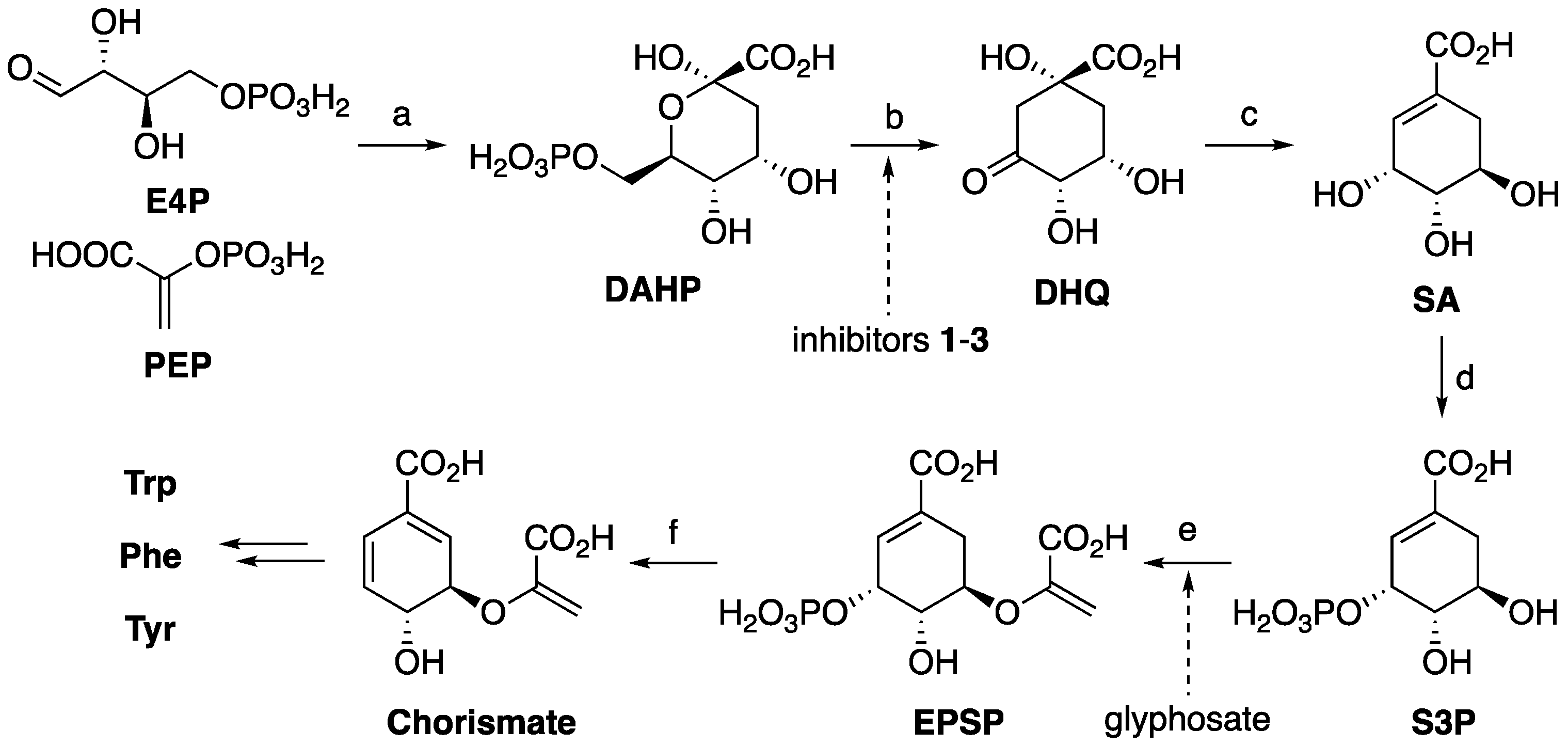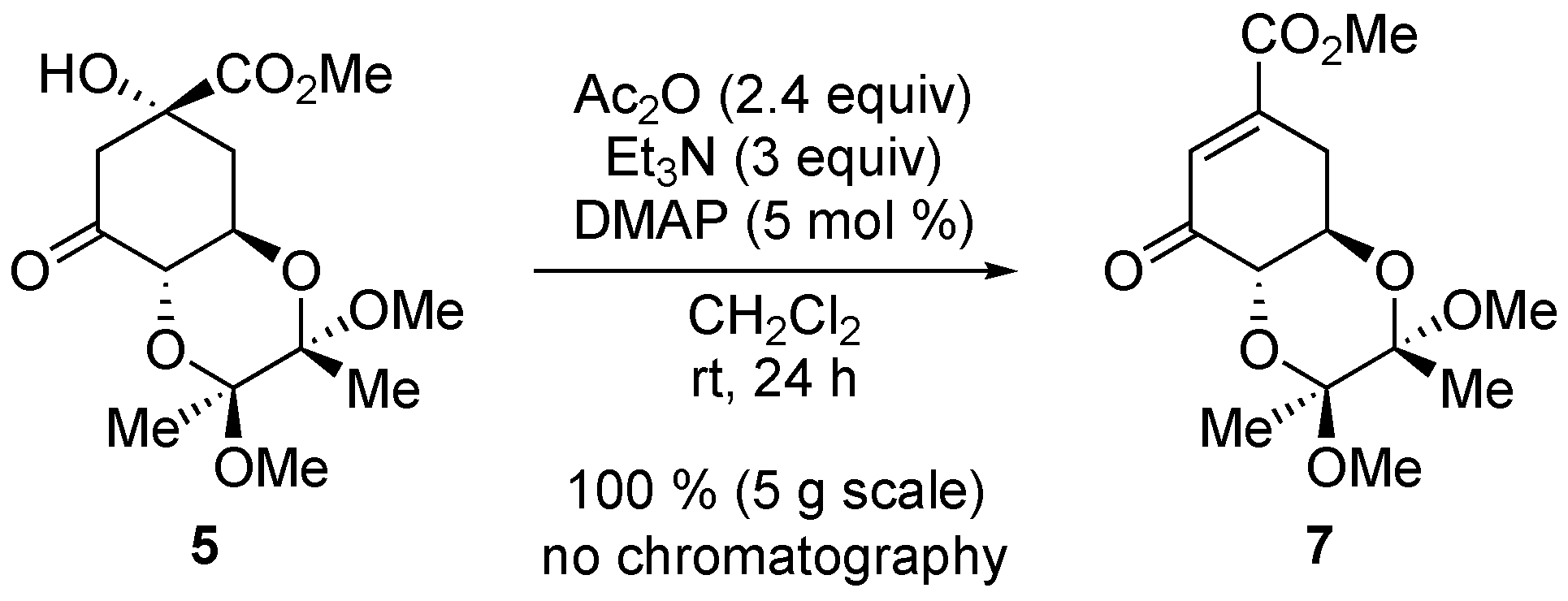Improved Synthesis of a Sub-Nanomolar Vinyl Phosphonate Inhibitor of Dehydroquinate Synthase
Abstract
1. Introduction
2. Results
2.1. Protection of Quinic Acid
2.2. Oxidation
2.3. Olefination
2.4. Hydrolysis
3. Discussion
4. Future Directions
5. Materials and Methods
5.1. General Chemistry
5.2. Reagent and Solvents
5.3. Experimental Procedures
Supplementary Materials
Author Contributions
Funding
Data Availability Statement
Acknowledgments
Conflicts of Interest
Abbreviations
| DHQS | 3-Dehydroquinate Synthase |
| Ki | Inhibition Constant |
| Km | Michaelis Constant |
| RBF | Round-bottom Flask |
References
- Montchamp, J.-L.; Frost, J.W. Cyclohexenyl and Cyclohexylidene Inhibitors of 3-Dehydroquinate Synthase: Active Site Interactions Relevant to Enzyme Mechanism and Inhibitor Design. J. Am. Chem. Soc. 1997, 119, 7645–7653. [Google Scholar] [CrossRef]
- Tian, F.; Montchamp, J.-L.; Frost, J.W. Inhibitor Ionization as a Determinant of Binding to 3-Dehydroquinate Synthase. J. Org. Chem. 1996, 61, 7373–7381. [Google Scholar] [CrossRef] [PubMed]
- Widlanski, T.; Bender, S.L.; Knowles, J.R. Dehydroquinate Synthase: A Sheep in Wolf’s Clothing? J. Am. Chem. Soc. 1989, 111, 2299–2300. [Google Scholar] [CrossRef]
- Bender, S.L.; Widlanski, T.; Knowles, J.R. Dehydroquinate synthase: The use of substrate analogs to probe the early steps of the catalyzed reaction. Biochemistry 1989, 28, 7560–7572. [Google Scholar] [CrossRef]
- Widlanski, T.; Bender, S.L.; Knowles, J.R. Dehydroquinate synthase: The use of substrate analogs to probe the late steps of the catalyzed reaction. Biochemistry 1989, 28, 7572–7582. [Google Scholar] [CrossRef]
- Dev, A.; Tapas, S.; Pratap, S.; Kumar, P. Structure and Function of Enzymes of Shikimate Pathway. Curr. Bioinform. 2012, 7, 374–391. [Google Scholar] [CrossRef]
- Knaggs, A.R. The biosynthesis of shikimate metabolites. Nat. Prod. Rep. 2003, 20, 119–136. [Google Scholar] [CrossRef]
- Mir, R.; Jallu, S.; Singh, T.P. The shikimate pathway: Review of amino acid sequence, function and three-dimensional structures of the enzymes. Crit. Rev. Microbiol. 2013, 41, 172–189. [Google Scholar] [CrossRef]
- Dewick, P.M. The biosynthesis of shikimate metabolites. Nat. Prod. Rep. 1995, 12, 101–133. [Google Scholar] [CrossRef]
- Shende, V.V.; Bauman, K.D.; Moore, B.S. The shikimate pathway: Gateway to metabolic diversity. Nat. Prod. Rep. 2024, 41, 604–648. [Google Scholar] [CrossRef]
- Carpenter, E.P.; Hawkins, A.R.; Frost, J.W.; Brown, K.A. Structure of dehydroquinate synthase reveals an active site capable of multistep catalysis. Nature 1998, 394, 299–302. [Google Scholar] [CrossRef] [PubMed]
- Duke, S.O. The history and current status of glyphosate. Pest Manag. Sci. 2018, 74, 1027–1034. [Google Scholar] [CrossRef] [PubMed]
- Duke, S.O.; Powles, S.B. Glyphosate: A once-in-a-century herbicide. Pest Manag. Sci. 2008, 64, 319–325. [Google Scholar] [CrossRef]
- Jastrzebowska, K.; Gabriel, I. Inhibitors of amino acids biosynthesis as antifungal agents. Amino Acids 2015, 47, 227–249. [Google Scholar] [CrossRef]
- Mehta, S.; Kumar, A.; Achary, V.M.M.; Ganesan, P.; Rathi, N.; Singh, A.; Sahu, K.P.; Lal, S.K.; Das, T.K.; Reddy, M.K. Antifungal activity of glyphosate against fungal blast disease on glyphosate tolerant OsmEPSPS transgenic rice. Plant Sci. 2021, 311, 1110009. [Google Scholar] [CrossRef]
- Roberts, C.W.; Roberts, F.; Lyons, R.E.; Kirisits, M.J.; Mui, E.J.; Finnerty, J.; Johnson, J.J.; Ferguson, D.J.P.; Coggins, J.R.; Krell, T.; et al. The Shikimate Pathway and Its Branches in Apicomplexan Parasites. J. Infect. Dis. 2002, 185 (Suppl. S1), S25–S36. [Google Scholar] [CrossRef]
- Frlan, R. An Evolutionary Conservation and Druggability Analysis of Enzymes Belonging to the Bacterial Shikimate Pathway. Antibiotics 2022, 11, 675. [Google Scholar] [CrossRef]
- Zhu, N.; Wang, X.; Li, D.; Lin, Y.; You, X.; Jiang, J.; Xu, Y.; Jiang, W.; Si, S. IMB-T130 targets 3-dehydroquinate synthase and inhibits Mycobacterium tuberculosis. Sci. Rep. 2018, 8, 17439. [Google Scholar] [CrossRef]
- Isa, M.A.; Majumdhar, R.S.; Haider, S. In silico docking and molecular dynamics simulation of 3-dehydroquinate synthase (DHQS) from Mycobacterium tuberculosis. J. Mol. Model. 2018, 24, 132. [Google Scholar] [CrossRef] [PubMed]
- Liu, J.-S.; Cheng, W.-C.; Wang, H.-J.; Chen, Y.-C.; Wang, W.-C. Structure-based inhibitor discovery of Helicobacter pylori dehydroquinate synthase. Biochem. Biophys. Res. Commun. 2008, 373, 1–7. [Google Scholar] [CrossRef]
- Montchamp, J.-L.; Tian, F.; Hart, M.E.; Frost, J.W. 2,3-Butane Bisacetal Protection of Vicinal Diequatorial Diols. J. Org. Chem. 1996, 61, 3897–3899. [Google Scholar] [CrossRef]
- Murray, L.M.; O’Brien, P.; Taylor, R.J.K. Stereoselective Reactions of a (−)-Quinic Acid-Derived Enone: Application to the Synthesis of the Core of Scyphostatin. Org. Lett. 2003, 5, 1943–1946. [Google Scholar] [CrossRef] [PubMed]
- Le Sann, C.; Abell, C.; Abell, A.D. A Convenient Method for the Synthesis of Dehydroquinic Acid. Synth. Commun. 2003, 33, 527–533. [Google Scholar] [CrossRef]
- Reddy, S.R.; Stella, S.; Chadha, A. Simplified Procedure for TEMPO-Catalyzed Oxidation: Selective Oxidation of Alcohols, α-Hydroxy Esters, and Amides Using TEMPO and Calcium Hypochlorite. Synth. Commun. 2012, 42, 3493–3503. [Google Scholar] [CrossRef]
- Fleitz, F.J.; Lyle, T.A.; Zheng, N.; Armstrong, J.D., III; Volante, R.P. Kilogram scale synthesis of the pyrazinone acetic acid core of an orally efficacious thrombin inhibitor. Synth. Commun. 2000, 30, 3171–3173. [Google Scholar] [CrossRef]
- Alves, C.; Barros, M.T.; Maycock, C.D.; Ventura, M.R. An efficient transformation of quinic acid to shikimic acid derivatives. Tetrahedron 1999, 55, 8443–8456. [Google Scholar] [CrossRef]
- Banwell, M.G.; Edwards, A.J.; Essers, M.; Jolliffe, K.A. Conversion of (−)-3-Dehydroshikimic Acid into Derivatives of the (+)-Enantiomer. J. Org. Chem. 2003, 68, 6839–6841. [Google Scholar] [CrossRef]
- Skiles, J.W.; Giannousis, P.P.; Fales, K.R. Asymmetric Synthesis of cis-(−)-(2R4S)-4-(Phosphonomethyl)-2-Piperidinecarboxylic Acid, A Potent NMDA Receptor Antagonist. Bioorganic Med. Chem. Lett. 1996, 6, 963–966. [Google Scholar] [CrossRef]
- Inui, M.; Nakazaki, A.; Kobayashi, S. Highly Stereoselective Construction of Spiro[4.5]decanes by SmI2-Promoted Ketyl Radical Mediated Tandem Cyclization. Org. Lett. 2007, 9, 469–472. [Google Scholar] [CrossRef]
- Xu, Y.; Flavin, M.T.; Xu, Z.-Q. Preparation of New Wittig Reagents and Their Application to the Synthesis of α,β-Unsaturated Phosphonates. J. Org. Chem. 1996, 61, 7697–7701. [Google Scholar] [CrossRef]
- Jeanmaire, T.; Hervaud, Y.; Boutevin, B. Synthesis of Dialkyl-Hydroxymethylphosphonates in Heterogeneous Conditions. Phosphorus Sulfur Silicon Relat. Elem. 2002, 177, 1137–1145. [Google Scholar] [CrossRef]
- Nielsen, B.E.; Stabile, S.; Vitale, C.; Bouzat, C. Design, Synthesis, and Functional Evaluation of a Novel Series of Phosphonate-Functionalized 1,2,3-Triazoles as Positive Allosteric Modulators of α7 Nicotinic Acetylcholine Receptors. ACS Chem. Neurosci. 2020, 11, 2688–2704. [Google Scholar] [CrossRef]
- Szajnman, S.H.; Montalvetti, A.; Wang, Y.; Docampo, R.; Rodriguez, J.B. Bisphosphonates Derived from Fatty Acids are Potent Inhibitors of Trypanosoma cruzi Farnesyl Pyrophosphate Synthase. Bioorganic Med. Chem. Lett. 2003, 13, 3231–3235. [Google Scholar] [CrossRef] [PubMed]
- Chiminazzo, A.; Sperni, L.; Fabris, F.; Scarso, A. Challenging synthesis of bisphosphonate derivatives with reduced steric hindrance. Tetrahedron Lett. 2021, 70, 153012–153015. [Google Scholar] [CrossRef]
- Jubeh, B.; Breijyeh, Z.; Karaman, R. Antibacterial Prodrugs to Overcome Bacterial Resistance. Molecules 2020, 25, 1543. [Google Scholar] [CrossRef]
- Cheng, A.V.; Wuest, W.M. The Prodrug Approach: A Successful Tool for Signed, Sealed, Delivered: Conjugate and Prodrug Strategies as Targeted Delivery Vectors for Antibiotics. ACS Infect. Dis. 2019, 5, 816–828. [Google Scholar] [CrossRef]
- Rautio, J.; Meanwell, N.A.; Di, L.; Hageman, M.J. The expanding role of prodrugs in contemporary drug design and development. Nat. Rev. Drug Discov. 2018, 17, 559–587. [Google Scholar] [CrossRef]
- Hartmann Jornada, D.; dos Santos Fernandes, G.F.; Chiba, D.E.; Ferreira de Melo, T.R.; dos Santos, J.L.; Chung, M.C. Improving Drug Solubility. Molecules 2016, 21, 42. [Google Scholar]
- Zawilska, J.B.; Wojcieszak, J.; Olejniczak, A.B. Prodrugs: A challenge for the drug development. Pharmacol. Rep. 2013, 65, 1–14. [Google Scholar] [CrossRef]
- Stella, V.J. Prodrugs: Some Thoughts and Current Issues. J. Pharm. Sci. 2010, 99, 4755–4765. [Google Scholar] [CrossRef]
- Stella, V.J.; Nti-Addae, K.W. Prodrug strategies to overcome poor water solubility. Adv. Drug Deliv. Rev. 2007, 59, 677–694. [Google Scholar] [CrossRef]
- Krečmerová, M.; Majer, P.; Rais, R.; Slusher, B.S. Phosphonates and Phosphonate Prodrugs in Medicinal Chemistry: Past Successes and Future Prospects. Front. Chem. 2022, 10, 889737. [Google Scholar] [CrossRef]
- Yu, H.; Yang, H.; Shi, E.; Tang, W. Development and Clinical Application of Phosphorus-Containing Drugs. Med. Drug Disc. 2020, 8, 100063. [Google Scholar] [CrossRef] [PubMed]
- Thornton, P.J.; Kadri, H.; Miccoli, A.; Mehellou, Y. Nucleoside Phosphate and Phosphonate Prodrug Clinical Candidates. J. Med. Chem. 2016, 59, 10400–10410. [Google Scholar] [CrossRef]
- Wiemer, A.J.; Wiemer, D.F. Prodrugs of Phosphonates and Phosphates: Crossing the Membrane Barrier. Top. Curr. Chem. 2015, 360, 115–160. [Google Scholar] [PubMed]
- Hecker, S.J.; Erion, M.D. Prodrugs of Phosphates and Phosphonates. J. Med. Chem. 2008, 51, 2328–2345. [Google Scholar] [CrossRef] [PubMed]
- Schultz, C. Prodrugs of Biologically Active Phosphate Esters. Bioorganic Med. Chem. 2003, 11, 885–898. [Google Scholar] [CrossRef]
- Hostetler, K.Y. Alkoxyalkyl prodrugs of acyclic nucleoside phosphonates enhance oral antiviral activity and reduce toxicity: Current state of the art. Antiviral Res. 2009, 82, A84–A98. [Google Scholar] [CrossRef]
- Li, H.; Hong, J.H. Synthesis and anti-HIV evaluation of new acyclic phosphonate nucleotide analogues and their bis(SATE) derivatives. Nucleosides Nucleotides Nucleic Acids 2010, 29, 581–590. [Google Scholar] [CrossRef]
- Olatunji, F.P.; Kesic, B.N.; Choy, C.J.; Berkman, C.E. Phosphoramidate derivates as controlled-release prodrugs of l-Dopa. Bioorganic Med. Chem. Lett. 2019, 29, 2571–2574. [Google Scholar] [CrossRef]
- Slusarczyk, M.; Serpi, M.; Pertusati, F. Phosphoramidates and phosphonamidates (ProTides) with antiviral activity. Antivir. Chem. Chemother. 2018, 26, 2040206618775243. [Google Scholar] [CrossRef] [PubMed]
- Choy, C.J.; Geruntho, J.J.; Davis, A.L.; Berkman, C.E. Tunable pH-Sensitive Linker for Controlled Release. Bioconjugate Chem. 2016, 27, 824–830. [Google Scholar] [CrossRef] [PubMed]
- Oliveira, F.M.; Barbosa, L.C.A.; Ismail, F.M.D. The diverse pharmacology and medicinal chemistry of phosphoramidates—A review. RSC Adv. 2014, 4, 18998–19012. [Google Scholar] [CrossRef]
- Choy, C.J.; Ley, C.R.; Davis, A.L.; Backer, B.S.; Geruntho, J.J.; Clowers, B.H.; Berkman, C.E. Second-Generation Tunable pH-Sensitive Phosphoramidate-Based Linkers for Controlled Release. Bioconjugate Chem. 2016, 27, 2206–2213. [Google Scholar] [CrossRef]
- Wiemer, A.J. Metabolic Efficacy of Phosphate Prodrugs and the Remdesivir Paradigm. ACS Pharmacol. Transl. Sci. 2020, 3, 613–626. [Google Scholar] [CrossRef]
- Foust, B.J.; Li, J.; Hsiao, C.-H.C.; Wiemer, D.F.; Wiemer, A.J. Stability and Efficiency of Mixed Aryl Phosphonate Prodrugs. ChemMedChem 2019, 14, 1597–1603. [Google Scholar] [CrossRef]











Disclaimer/Publisher’s Note: The statements, opinions and data contained in all publications are solely those of the individual author(s) and contributor(s) and not of MDPI and/or the editor(s). MDPI and/or the editor(s) disclaim responsibility for any injury to people or property resulting from any ideas, methods, instructions or products referred to in the content. |
© 2025 by the authors. Licensee MDPI, Basel, Switzerland. This article is an open access article distributed under the terms and conditions of the Creative Commons Attribution (CC BY) license (https://creativecommons.org/licenses/by/4.0/).
Share and Cite
Fitterer, E.; Montchamp, J.-L. Improved Synthesis of a Sub-Nanomolar Vinyl Phosphonate Inhibitor of Dehydroquinate Synthase. Molecules 2025, 30, 3594. https://doi.org/10.3390/molecules30173594
Fitterer E, Montchamp J-L. Improved Synthesis of a Sub-Nanomolar Vinyl Phosphonate Inhibitor of Dehydroquinate Synthase. Molecules. 2025; 30(17):3594. https://doi.org/10.3390/molecules30173594
Chicago/Turabian StyleFitterer, Ella, and Jean-Luc Montchamp. 2025. "Improved Synthesis of a Sub-Nanomolar Vinyl Phosphonate Inhibitor of Dehydroquinate Synthase" Molecules 30, no. 17: 3594. https://doi.org/10.3390/molecules30173594
APA StyleFitterer, E., & Montchamp, J.-L. (2025). Improved Synthesis of a Sub-Nanomolar Vinyl Phosphonate Inhibitor of Dehydroquinate Synthase. Molecules, 30(17), 3594. https://doi.org/10.3390/molecules30173594







